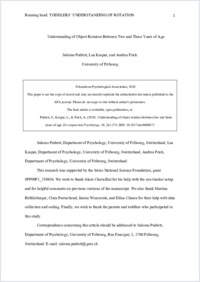Understanding of object rotation between two and three years of age
- Pedrett, Salome Universität Fribourg
- Kaspar, Lea Universität Fribourg
- Frick, Andrea Universität Fribourg
-
2020
Published in:
- Developmental Psychology. - 2020, vol. 56, p. 261-274
English
Toddlers’ understanding of object rotation was investigated using a multi-method approach. Participants were 44 toddlers between 22 and 38 months of age. In an eye-tracking task, they observed a shape that rotated and disappeared briefly behind an occluder. In an object-fitting task, they rotated wooden blocks and fit them through apertures. Results of the eye-tracking task showed that with increasing age, the toddlers encoded the visible rotation using a more complex eye-movement pattern, increasingly combining tracking movements with gaze shifts to the pivot point. During occlusion, anticipatory looks to the location where the shape would reappear increased with age, whereas looking back to the location where the shape had just disappeared decreased. This suggests that, with increasing age, the toddlers formed a clearer mental representation about the object and its rotational movement. In the object-fitting task, the toddlers succeeded more with increasing age, and also rotated the wooden blocks more often correctly before they tried to insert them. Importantly, these preadjustments correlated with anticipatory eye movements, suggesting that both measures tap the same underlying understanding of object rotation. The findings yield new insights into the relation between tasks using looking times and behavioral measures as dependent variables, and thus may help to clarify performance differences that have previously been observed in studies with infants and young children.
- Faculty
- Faculté des lettres et des sciences humaines
- Department
- Département de Psychologie
- Language
-
- English
- Classification
- Psychology
- License
-
License undefined
- Identifiers
-
- RERO DOC 328137
- DOI 10.1037/dev0000871
- Persistent URL
- https://folia.unifr.ch/unifr/documents/308500
Statistics
Document views: 97
File downloads:
- Texte intégral: 497
